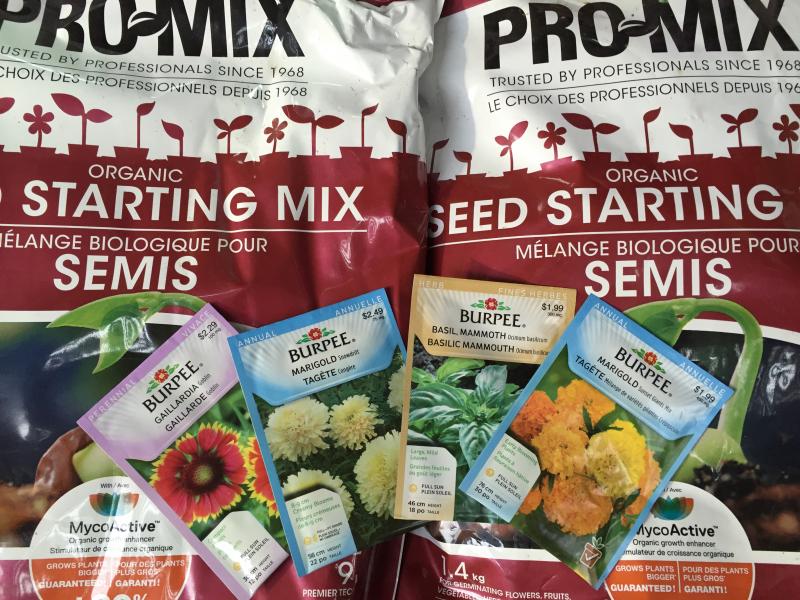In February, a good percentage of phone calls to the garden centre relate to the question … "Are the seeds in yet?" It is late winter when gardeners, in anticipation of getting their plans in motion, begin to seek out their favored seed; as well, seek out the "new" seed varieties. They are planning their gardens. They are planning to seed.
We seek out favorite seed packets among the vast selections; sometimes, difficult to resist picking new varieties. Easily, seed displays can hold up to a hundred or more packets with herbs, vegetables, perennials, annuals and occasionally ornamental grasses. How do you choose? Is it the seed brand, the colorful packaging, the unique flower, or the thought of creating a new vegetable garden that draws us? It could be one, or all of these traits that draws our interest. Over the last few years, persons are seeking the heritage seed.
Greenhouse operations choose seed in a similar way. Schedules are organized based on selections ranging in heights, color, texture, blooming period; and harvest date when planning on growing edible vegetables and herbs. Greenhouse operations too, can be limited with what they grow; choosing the staple plants everyone is looking for and then choosing those upcoming new varieties.
Greenhouse operations maintain histories of seeding schedules for their productions; possessing knowledge of when and how to grow. For the homeowner, seed companies list information on the seed packages.

Reading a seed packet can be an adventure in itself. Avid gardeners know the varieties they seek, the growing conditions for these plants, and the growth habit of these plants by heart. It is the new gardener, or the experienced gardener seeking a new item, that is driven to seek out information on the seed packet they have just selected.
The colorful packets measuring only 4"x5" relay to us a percentage of information valuable to the success of the seeds growth. These packets generally give the guidelines for planting. Vegetable and herb packets define the seed depth and spacing for row plantings. Perennial and annual plant selections specifically state seeding times for two methods of seeding. One method is seeding indoors for early germination, and progressed growth before planting outdoors when the weather permits. The second method is to seed directly in the garden where the seed will germinate and continue to grow without being transplanted. Seeding indoors may require some seedling varieties to be transplanted to slightly larger containers as they quickly outgrow their original containers.

Information listed, such as days of germination and days to maturity are important facts. This is the part of plant biology that is amazing. Different seeds germinate at different time frames, and may mature at different rates. This may be noted on the packet with the phrase "days to maturity". As with greenhouse operations, scheduling your plants for seeding is done based on "days of germination" and as well "days to maturity". Examples of this are: some marigold, will germinate in 2 – 3 days whereas some perennials, or even annual seeds such cleome and Datura take 14 – 21 days. It is not unusual for one genus – i.e. marigolds, which have numerous varieties, to have different sow dates and germination times. I.e. Marigold ‘Crush’ Series should be seeded by early March, whereas Marigold ‘Safari Series’ and ‘Disco Series’ do best seeded in late March or early April. Note also, seed varieties that are best only when directly sown in soil outdoors, i.e. corn.

Occasionally, additional information may also be found on the seed packet such as flower/plant height or plant width. This may assist in the decision of how may seeds and eventually plants the homeowner will want. Guidelines, such as ‘soaking the seed before planting’ (i.e. morning glories and lupine seed); "keep seed uniformly moist until germinated", or mention of growing medium are noted.
Seeds vary in sizes from the tiniest speck, to those larger than those of kidney beans. Sowing depth can be a bit confusing as most would think to place seeds deep in the soil. This is not always the case. Larger seed, sizes similar to corn and beans benefit from being placed twice its size in depth into the growing mixture, while small seed does best when placed on the surface of the growing medium (peat mixture) then gently pressed; but not covered. Seeds profit from a moist atmosphere. Trays and clear dome covers are available at garden centers which resemble mini greenhouse effects, keeping moisture and allowing light through. Maintaining heat on your mini greenhouse will aid in seeds germinating those seeds chosen to germinate earlier indoors.

Seeding is an exciting way to begin plants for your garden; often a hobby, and a welcoming learning when shared with younger children. Garden centres have the expertise to assist you with your inquiries. Soon, additional selections of seeds will be on hand for when you are ready to start your seeds.
St. Mary’s Nursery & Garden Centre is open year round. Gearing up already for spring, St. Mary’s too will begin its seeding schedule for this year’s growing program. St. Mary’s Nursery is your destination for all your seeding needs.








